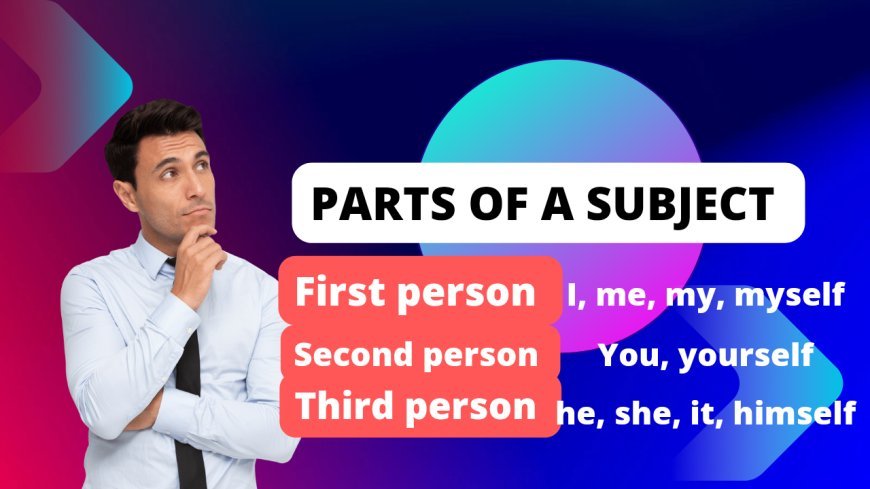Parts Of A Subject

********************************************
Types Of Subject -
विषय के प्रकार -
a) First Person
b) Second Person
c) Third Person
a) First Person:-
(I, me, my, mine, we, our, us)
"The first person"perspective is an important part of writing and speaking, as it allows the speaker or writer to establish their point of view and connect with their audience.
"पहला व्यक्ति परिप्रेक्ष्य" लेखन और बोलने का एक महत्वपूर्ण हिस्सा है, क्योंकि यह वक्ता या लेखक को अपनी बात स्थापित करने और अपने दर्शकों से जुड़ने की अनुमति देता है।
There are four forms of first person:-
"प्रथम व्यक्ति" के चार रूप हैं:-
1) First Person Singular "I" or "me"-
पहला व्यक्ति एकवचन "I" or "me"-
First person "I" is speaker themselves.
पहला व्यक्ति "मैं" स्वयं वक्ता है।
Example:
- "I am laughing."
- "I must look for a good chimney pot."
- "I am the happy prince."
- "I am waited for in Egypt."
- "I hope my dress will be ready in time."
- "Will you not stay with me one night longer."Here the word "me" is a person who is speaking.यहाँ "मैं" शब्द एक व्यक्ति है जो बोल रहा है।
- You tell me of marvellous things."Here the word "me" is a person who is speaking.यहाँ "मैं" शब्द एक व्यक्ति है जो बोल रहा है।
- "Will you let me kiss your hand."The word "me" is a person who is speaking, in this case, the person who is asking the question.शब्द "मैं" एक व्यक्ति है जो बोल रहा है, इस मामले में, वह व्यक्ति जो प्रश्न पूछ रहा है।
2) First Person Plural "We" -
प्रथम व्यक्ति बहुवचन "हम"-
First person "we" are speaker & one or more other people.
प्रथम व्यक्ति "हम" वक्ता और एक या अधिक अन्य लोग हैं।
Example:
- "We are going to the school."
- "We need not talk about the poet."
- "We have introduced the old exercise of dictation again."
- "We will have a nice little talk about yourself."
- "We know you run a car."
- "We think you are smart."
- "We saw your in the car."
- "We know that you are telling the truth."
3) First person possessive: "my" or "our" -
पहला व्यक्ति स्वामित्व: "मेरा" या "हमारा"
used to indicate ownership or possession by the speaker or group of speakers.
स्पीकर या वक्ताओं के समूह द्वारा स्वामित्व या कब्जे को इंगित करने के लिए उपयोग किया जाता है।
Example:
- "My car is in the garage."Here "my" indicate ownership of car.यहां "मेरा" कार के स्वामित्व को दर्शाता है।
- "Our house is on the corner."Here "our" indicate ownership of house.यहाँ "हमारा" घर के स्वामित्व को दर्शाता है।
- "My speciality is jewel robbery."Here "my" indicate ownership of speciality.यहाँ "मेरा" विशेषता के स्वामित्व को दर्शाता है।
- "It was not a tribute to our intelligence. Here "our" indicate ownership of intelligence."यहाँ "हमारा" बुद्धि के स्वामित्व को दर्शाता है।"
- "It was my fault."Here "my" indicate ownership of fault.यहाँ "मेरा" दोष के स्वामित्व को दर्शाता है।
- "Our mother baked cake for us."Here "our" indicate ownership or possession of mother.यहाँ "हमारा" माँ के स्वामित्व या अधिकार को दर्शाता है।
- "My teacher looks very young."Here "my" indicate ownership or possession of teacher.यहाँ "मेरा" शिक्षक के स्वामित्व या कब्जे को दर्शाता है।
- "We celebrated Diwali in our house."Here "our" indicate ownership of house.यहाँ "हमारा" घर के स्वामित्व को दर्शाता है।
4).First person reflexive: "myself"(singular) or "ourselves"(plural) -
when the subject and the object of a sentence are the same it is called a reflexive pronoun. In other words when the action of the verb is being performed by the subject on itself it is called a reflexive pronoun.
जब किसी वाक्य का कर्ता और वस्तु एक ही हो तो उसे निजवाचक सर्वनाम कहते हैं। दूसरे शब्दों में जब क्रिया की क्रिया कर्ता द्वारा स्वयं पर की जा रही हो तो उसे निजवाचक सर्वनाम कहते हैं।
Example:
- "I never imagined myself going home so early." Here "I" & "myself" both are same person.यहाँ "मैं" और "myself" दोनों एक ही व्यक्ति हैं।
- "We all enjoyed ourselves."Here "We & ourselves" both are same person.यहाँ "हम और ourselves" दोनों एक ही व्यक्ति हैं।
- "I made myself ill by eating fast food. Here "I" & "myself" both are same person.यहाँ "मैं" और "myself" दोनों एक ही व्यक्ति हैं।
- "He was roughly the same age as ourselves. Here "speaker & ourselves" both are same person.यहाँ "वक्ता और हम" दोनों एक ही व्यक्ति हैं।
- "I will not myself tomorrow. Here "I" & "myself" both are same person.यहाँ "मैं" और "myself" दोनों एक ही व्यक्ति हैं।
- "We felt ashamed of ourselves. Here "We & ourselves" both are same person.यहाँ "हम और ourselves" दोनों एक ही व्यक्ति हैं।
- "I am proud of myself. Here "I" & "myself" both are same person.यहाँ "मैं" और "myself" दोनों एक ही व्यक्ति हैं।
- "We are honest with ourselves. Here "We & ourselves" both are same person.यहाँ "हम और ourselves" दोनों एक ही व्यक्ति
................................................................................
In the next article we will study second part of a "subject" i.e, "second person."
अगले लेख में हम एक "विषय" के दूसरे भाग अर्थात "दूसरा व्यक्ति" का अध्ययन करेंगे।
******************************************
What's Your Reaction?


























































